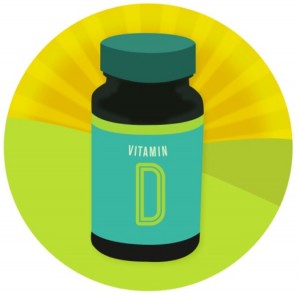
Editor’s Note: This sponsored health and fitness column is written by Ginny Wright, founder of BbG Fitness, which offers group fitness classes around Arlington. Sign up for a free class today.
When was the last time you spent any time in the sun without slathering on sunscreen first? Most of us are well aware of the risks of unprotected sun exposure, but what we may not know is that avoiding direct sunlight could actually be doing us more harm than good!
I am not suggesting we recklessly ditch our sunscreen altogether. But it’s definitely worth taking a closer look at vitamin D and its potential health benefits, including disease prevention and, in some cases, treatment.
 Vitamin D has been in the news a lot lately, with new research findings nearly every month. We now know that vitamin D can benefit multiple sclerosis, heart disease, the immune system and bone health. But its greatest benefits may come in the form of treatment and prevention of certain cancers: prostate, breast, ovaries, cervix, pancreas, lungs, colon, bladder, esophagus and brain as well as non-Hodgkin’s lymphoma, multiple myeloma and melanoma.
Vitamin D has been in the news a lot lately, with new research findings nearly every month. We now know that vitamin D can benefit multiple sclerosis, heart disease, the immune system and bone health. But its greatest benefits may come in the form of treatment and prevention of certain cancers: prostate, breast, ovaries, cervix, pancreas, lungs, colon, bladder, esophagus and brain as well as non-Hodgkin’s lymphoma, multiple myeloma and melanoma.
Throughout evolution humans were naturally and continuously exposed to the sun. But today, many of us spend so much of our days indoors that we’ve become severely vitamin D deficient — and therefore at higher risk for everything from bone fractures to cancer. In fact, researchers from the Moore’s Cancer Center at the University of California, San Diego concluded that increasing the intake of vitamin D3 throughout the world could easily prevent many diseases, including 16 types of cancer.
Show Some Skin
Some experts actually believe that melanoma is not caused from sun exposure. The Vitamin D Council says research to date shows that moderate but frequent sun exposure is healthy, while overexposure and intense exposure can increase your risk of skin cancer. Edward Giovannucci, professor of nutrition and epidemiology at The Harvard School of Public Health, says “Evidence shows modest exposure to sun can have long-term benefits.”
How Much Vitamin D Do We Need and How Can We Get It?
Unfortunately it’s nearly impossible to get enough vitamin D in our diets. That leaves direct sun exposure and supplements in the form of vitamin D3.
The safe and optimal amount of sun exposure to produce enough vitamin D varies from individual to individual. Several factors help determine your personal needs: the time of day (the closer to midday the more vitamin D is produced), where you live in the world (closer to the equator is better) and the color of your skin (the paler your skin the more easily you can produce vitamin D). The more skin you expose the more vitamin D is produced. Time ranges anywhere from 15 minutes for a very fair-skinned person to a couple of hours or more for a dark skinned person.
In fact, your body can produce 10,000 to 25,000 IU of vitamin D in just a little under the time it takes for your skin to turn pink! You make the most vitamin D when you expose a large area of your skin, such as your back, rather than a small area like your face or arms. Always use caution to avoid burning your skin. The Vitamin D Council believes that covering up with clothing and/or going into the shade (after you get a little bit of sun exposure) is safer than using sunscreen to protect yourself from too much sun exposure.
How Much Vitamin D Should I Take in The Form of Supplements?
Taking a supplement is an effective way to get vitamin D, especially if you’re worried about exposing your skin to the sun.
Different organizations recommend taking different amounts. The Vitamin D Council suggests adults take 5,000 IU per day, while the Food and Nutrition Council of the US Government recommends just 600 IU’s per day.
The only true way to know how much vitamin D your body needs is to get regular testing—every six months or so. The correct test is 25(OH)D, also called 25-hydroxyvitamin D. This is the better marker of overall D status, and is most strongly associated with overall health. You can order the test through your doctor, use Labcorp or take your own home test. Congratulations if your results show your level is in the ideal target range of between 40-50 ng/ml!
Stay well and keep those Vitamin D levels high!
Ginny Wright has been a certified personal trainer and fitness instructor for more than 10 years. She received her Health Coaching certification through the Institute for Integrative Nutrition in New York in 2007. The views and opinions expressed in the column are those of the author and do not necessarily reflect the views of ARLnow.com.

